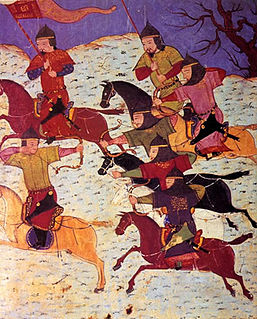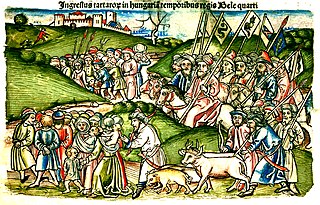
The Mongol invasion of Kievan Rus' was part of the Mongol invasion of Europe, in which the Mongol Empire invaded and conquered Kievan Rus' in the 13th century, destroying numerous cities, including Ryazan, Kolomna, Moscow, Vladimir and Kiev, with the only major cities escaping destruction being Novgorod and Pskov.

Giovanni da Pian del Carpine, variously rendered in English as John of Pian de Carpine, John of Plano Carpini or Joannes de Plano, was a medieval Italian diplomat, archbishop and explorer and one of the first Europeans to enter the court of the Great Khan of the Mongol Empire. He is the author of the earliest important Western account of northern and central Asia, Rus, and other regions of the Mongol dominion. He was the Primate of Serbia, based in Antivari, from 1247 to 1252.

Güyük was the third Khagan-Emperor of the Mongol Empire, the eldest son of Ögedei Khan and a grandson of Genghis Khan. He reigned from 1246 to 1248.

William of Rubruck, also known as Willem van Ruysbroeck, Guillaume de Rubrouck, or Willielmus de Rubruquis, was a Flemish Franciscan missionary and explorer. He is best known for his travels to various parts of the Middle East and Central Asia in the 13th century, including the Mongol Empire. His account of his travels is one of the masterpieces of medieval geographical literature, comparable to those of Marco Polo and Ibn Battuta.

Benedict of Poland was a Polish Franciscan friar, traveler, explorer, and interpreter.
Saqsin was a medieval city that flourished from the eleventh to the thirteenth centuries. It was situated in the Volga Delta, or in the Lower Volga region, and was known in pre-Mongol times as Saksin-Bolgar, which in Mongol times became Sarai Batu. It was mentioned by the Arab geographer al-Gharnati and the Persian Qazwini, among others, and recorded as "the land of the Saksins" in the report of Friar Benedykt Polak about the 1246 trip of Giovanni da Pian del Carpine through the camp of Mongol prince Batu Khan on the shores of the Volga. S.A. Pletneva locates Saksin between present Volgograd and Akhtubinsk.

Sorghaghtani Beki or Bekhi, also written Sorkaktani, Sorkhokhtani, Sorkhogtani, Siyurkuktiti was a Keraite princess and daughter-in-law of Genghis Khan. Married to Tolui, Genghis' youngest son, Sorghaghtani Beki became one of the most powerful and competent people in the Mongol Empire. She made policy decisions at a pivotal moment that led to the transition of the Mongol Empire towards a more cosmopolitan and sophisticated style of administration. She raised her sons to be leaders, and maneuvered the family politics so that all four of her sons, Möngke Khan, Hulagu Khan, Ariq Böke, and Kublai Khan, went on to inherit the legacy of their grandfather.
The Brutakhi were a Jewish polity of uncertain location and origin during the early 13th century.
Simon of Saint-Quentin was a Dominican friar and diplomat who accompanied Ascelin of Lombardia on an embassy which Pope Innocent IV sent to the Mongols in 1245. Simon’s account of the mission, in its original form, is lost; but a large section has been preserved in Vincent of Beauvais’ Speculum Historiale, where nineteen chapters are expressly said to be ex libello fratris Simonis.

Orda Ichen, was a Mongol Khan and military strategist who ruled the eastern part of the Golden Horde during the 13th century.

Magna Hungaria, literally "Great Hungary" or "Ancient Hungary", refers to the ancestral home of the Hungarians.

Ascelin of Lombardy, also known as Nicolas Ascelin or Ascelin of Cremona, was a 13th-century Dominican friar whom Pope Innocent IV sent as an envoy to the Mongols in March 1245. Ascelin met with the Mongol ruler Baiju, and then returned to Europe with a message and Mongol envoys in 1248.
Lawrence of Portugal was a Franciscan friar and an envoy sent by Pope Innocent IV to the Mongols in 1245.
Roman Mikhailovich the Old was a Rus' prince. He was prince of Chernigov, and of Bryansk.

Mongol elements in Western medieval art can be seen in European works of art ranging from the 13th to the 15th century. They encompass artistic areas such as painting and textile manufacture, and mainly consist in the European use of Mongol 'Phags-pa script in Medieval European art, as well as the representation of "Tartar" cloth and Mongol soldiers in a number of contemporary European paintings.
An orda or horde was a historical sociopolitical and military structure found on the Eurasian Steppe, usually associated with the Turkic and Mongol peoples. This form of entity can be seen as the regional equivalent of a clan or a tribe. Some successful ordas gave rise to khanates.
Polish–Mongolian literary relations are the interrelationships between Polish and Mongolian literature that date to the late Middle Ages. There are also links between Polish and Mongolian philology and literary studies. Their first manifestations were reports about Mongols in the Polish chronicles and in the relations of medieval Polish travelers to Asia. Knowledge about Mongolia in Poland became more vivid in the 19th century, when many Polish adventurers, prisoners in Siberia, learned people and businessmen of the part of Poland under Russian rule engaged heavily in Siberian, Mongolian, and Chinese affairs. Interest in Polish matters in Mongolia is smaller and dates mainly to the 20th century. There are also literary works about Mongolia in the Polish literature and a few translations of Polish literature into Mongolian, or Mongolian literature into Polish.

The first Mongol invasion of Hungary started in March 1241 and started to withdraw in late March 1242.

The Tartar Relation is an ethnographic report on the Mongol Empire composed by a certain C. de Bridia in Latin in 1247. It is one of the most detailed accounts of the history and customs of the Mongols to appear in Europe around that time.
Stephen of Bohemia was a Franciscan friar and a member of the Papal mission to the Mongol Empire in 1245–1247.











